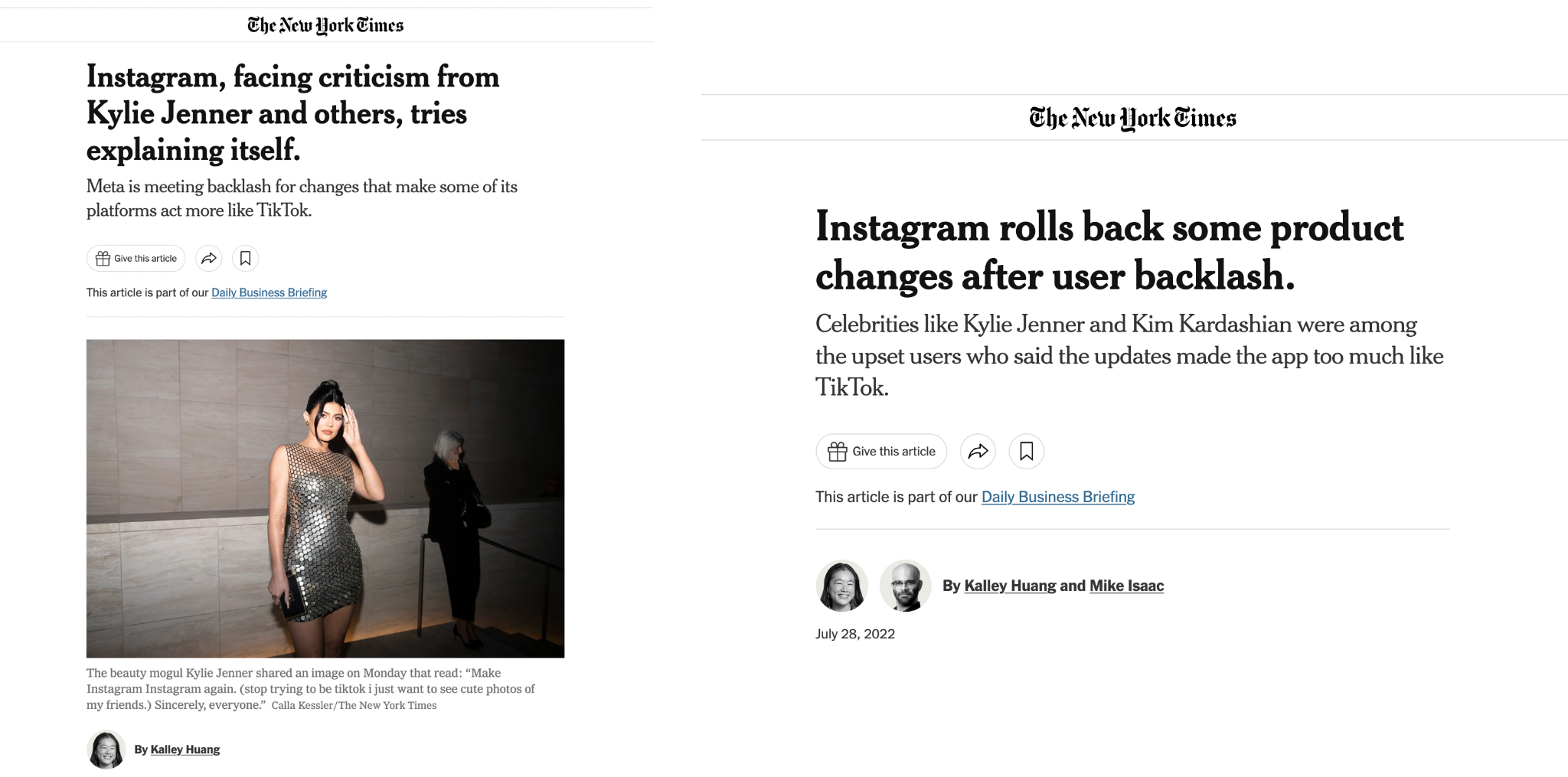Share this
Instagram's Failed Pivot to Mimic TikTok
by Henry Chapman on August 4, 2022
Charting Instagram's Pivots to Stay Competitive
Instagram's iterative history
Meta’s Instagram has grown its popularity over the last decade by copying and iterating on other apps’ core features. Instagram first did this to Snapchat in 2016 by copying its “Story” feature. It did this successfully and captured the short-form, narrative image market for the next three years.
In July 2020, Instagram once again tried to feature-replicate, this time with the hugely successful video-forward TikTok. In this brief, we examine the results of this pivot, and suggest reasons why it failed.
Instagram copies Snapchat stories (2016)
While Facebook acquired Instagram in 2012, Snapchat remained independent and enjoyed steady growth. Around 2016, Facebook engineers saw Snapchat’s growing popularity as an existential threat to their business. As a result, they adopted a core feature - the Snapchat Story. Infegy Atlas data shows that Instagram copied this masterfully, as post-volume dropped for Snapchat, but continued to climb for Instagram.
.png)
Figure 1: Post volume graph shows that SnapChat almost overtook Instagram in post volume in 2016.
Instagram pivots to short form video (2022)
Instagram faced a similar challenge in 2022 with TikTok, the short-form video app, siphoning off younger users with its addictive algorithm and short-term video content. Instagram tried to copy TikTok by placing full-screen video over Instagram’s traditional image feed.
.png)
Figure 2: Post volume graph shows that while SnapChat volume consistently declined since 2016, Instagram’s stopped growing. This enabled TikTok to become competitive.
Users complain
Users saw Instagram’s pivot and complained. Instagram user @illumitati started the complaints with a post proclaiming, “Make Instagram Instagram Again.” This post was retweeted by the Kardashian siblings and garnered millions of likes and shares.
Many of these complaints centered around Instagram creators having to revise their creative process and completely change how they generated content for Instagram.

Figure 3: Screenshot of @Illuminati's Instagram post.
Spike in post volume showcases user complaints

Figure 4: Post Volume graph showing the various spikes around the #MakeInstagramInstagramAgain movement, starting on July 17, 2022
Infegy Atlas tells the story of the “Make Instagram Instagram Again” movement with post volume. @illumitati shared her post early on. The Kardashians picked it up a few days later near the peak of the post volume. Instagram reversed course quickly after that. The final hump shows post-controversy commentary.
Users tell Instagram: "Stop trying to be TikTok"

Figure 5: Word Cloud of topics relating to #MakeInstagramInstagramAgain. Note the appearance of Kim Kardashian and Adam Mosseri
This Infegy Atlas word cloud showcases the main complaints and complainers driving the conversation around Instagram’s changes. While Tati Bruening (@illumitati) appears in the word cloud, the main voices driving the conversation come from mega-influencers Kim Kardashian and Kylie Jenner. The complaints center around the remark that Instagram should “stop trying to be TikTok.”
Instagram reverses course

Figure 6: Mainstream News Outlets report on Instagram Reversing Course
Notably, Instagram reversed course just a few days after the backlash. This is significant because Meta has shown great reticence to listen to consumer backlash in the past. It remains to be seen whether Instagram can pivot to meet TikTok’s surging demand without alienating its creators. That question remains unanswered.
Conclusion
Instagram’s attempt to pivot to an immersive, full-screen video experience backfired spectacularly. This means Instagram’s playbook of copying other platform’s cornerstone features won’t work like it did in 2016. This failed business strategy showcases serious concern around Instagram’s ability to remain relevant amongst a more competitive marketplace. In 2022, social media users have more options where they can spend their time. In order to attract the crowds, Instagram will have to innovate, not just copy.
Instagram's Strategic Pivots and Their Outcomes
Instagram has been known for its approach of replicating features from competitor apps, like Snapchat's Story in 2016 and TikTok's video format in 2022. While successful initially, recent efforts faced backlash from creators and influencers.
The Copycat Strategy: Success and Stumbles
Instagram copied Snapchat's Story feature in 2016, leading to increased user engagement. However, Instagram's 2022 pivot to TikTok-like full-screen video content drew significant user complaints, leading to a reversal of strategy.
User Backlash: "Make Instagram Instagram Again"
Instagram's attempt to mimic TikTok led to an outcry initiated by users, replicated by mega-influencers like Kim Kardashian, urging Instagram to return to its roots. This movement highlighted user dissatisfaction with changes.
Instagram's Response and Future Challenges
Responding to backlash, Instagram quickly moved away from its TikTok-like changes. This incident emphasizes that Instagram must innovate rather than imitate to stay relevant in an increasingly competitive market.
Share this
- April 2025 (1)
- March 2025 (1)
- February 2025 (4)
- January 2025 (1)
- December 2024 (2)
- November 2024 (2)
- October 2024 (4)
- September 2024 (2)
- August 2024 (2)
- July 2024 (2)
- June 2024 (2)
- May 2024 (2)
- April 2024 (2)
- March 2024 (2)
- February 2024 (2)
- January 2024 (2)
- December 2023 (3)
- November 2023 (4)
- October 2023 (4)
- September 2023 (4)
- August 2023 (4)
- July 2023 (4)
- June 2023 (3)
- May 2023 (5)
- April 2023 (3)
- March 2023 (6)
- February 2023 (3)
- January 2023 (4)
- December 2022 (2)
- November 2022 (3)
- October 2022 (4)
- September 2022 (2)
- August 2022 (3)



.png?width=64&height=64&name=linkedin%20(1).png)
